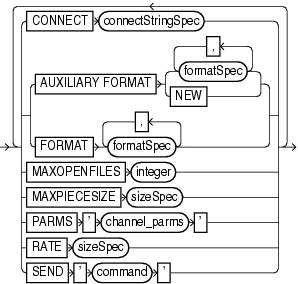| Oracle® Database Backup and Recovery Reference 11g Release 1 (11.1) Part Number B28273-01 |
|
|
View PDF |
| Oracle® Database Backup and Recovery Reference 11g Release 1 (11.1) Part Number B28273-01 |
|
|
View PDF |
Purpose
Use the allocOperandList subclause to control options on a channel, which is a connection between RMAN and a database instance.
Syntax
allocOperandList::=

(connectStringSpec::=, formatSpec::=)
sizeSpec::=

Semantics
| Syntax Element | Description |
|---|---|
CONNECT connectStringSpec |
Specifies a connect string to the database instance where RMAN should conduct the backup or restore operations. Use this parameter to spread the work across different instances in an Oracle RAC configuration.
If you do not specify this parameter, and if you did not specify the See Also: |
AUXILIARY FORMAT |
Specifies the format of image copies created on an auxiliary instance.
RMAN must be connected to the auxiliary instance with |
formatSpec |
Specifies a pattern for image copy names on an auxiliary instance.
The path must be valid on the auxiliary host. See Also: |
NEW |
Creates an image copy in the directory specified by the DB_CREATE_FILE_DEST initialization parameter of the auxiliary instance.
The image copy name is in an Oracle Managed Files format. |
FORMAT formatSpec |
Specifies the format to use for the names backup pieces or image copies created on this channel. Example 3-1 illustrates this technique.
The If you do not specify You can specify up to four Because the channels correspond to server sessions on the target database, the See Also: |
MAXOPENFILES integer |
Controls the maximum number of input files that a BACKUP command can have open at any given time (the default is 8). Use this parameter to prevent "Too many open files" error messages when backing up a large number of files into a single backup set. |
MAXPIECESIZE sizeSpec |
Specifies the maximum size of each backup piece created on this channel. Example 3-2 illustrates this technique. Specify the size in bytes, kilobytes (K), megabytes (M), or gigabytes (G). The default setting is in bytes and is rounded down into kilobytes. For example, if you set MAXPIECESIZE to 5000, RMAN sets the maximum piece size at 4 kilobytes, which is the lower kilobyte boundary of 5000 bytes.
Note: You cannot use |
PARMS 'channel_parms' |
Specifies parameters for the sbt channel. Example 3-3 illustrates this technique. Do not use this port-specific string if you have specified DEVICE TYPE DISK.
You can use the following formats for the channel parameters:
See Also: Oracle Database Backup and Recovery User's Guide to learn how to integrate media management libraries |
RATE sizeSpec |
Sets the maximum number of bytes (default), kilobytes (K), megabytes (M), or gigabytes (G) that RMAN reads each second on this channel. This parameter sets an upper limit for bytes read so that RMAN does not consume too much disk bandwidth and degrade performance. |
SEND 'command' |
Sends a vendor-specific command string to all allocated channels. For example, you could specify an Oracle Secure Backup media family with SEND 'OB_MEDIA_FAMILY datafile_mf'.
See Also: Your media manager documentation to determine whether this feature is supported and when it should be used |
sizeSpec
This subclause specifies the size of data. Refer to sizeSpec::= for the syntax diagram.
| Syntax Element | Description |
|---|---|
integer [G | K | M] |
Specifies the size of data in gigabytes (G), kilobytes (K), or megabytes (M). |
Examples
Example 3-1 Specifying the Default Location for Disk Backups
This example allocates a disk channel that specifies a nondefault format, and then backs up the database to the nondefault location.
RUN
{
ALLOCATE CHANNEL d1 DEVICE TYPE DISK FORMAT = '/disk1/bkup_%U';
BACKUP DATABASE;
}
Example 3-2 Setting the Maximum Size of a Backup Piece
This example manually allocates an SBT channel, which specifies an Oracle Secure Backup tape drive, and makes a whole database backup. The MAXPIECESIZE parameter specifies that no backup piece written to tape should exceed 800 MB.
RUN
{
ALLOCATE CHANNEL c1 DEVICE TYPE sbt
PARMS 'SBT_LIBRARY=/usr/local/oracle/backup/lib/libobk.so, ENV=(OB_DEVICE_1=stape1)'
MAXPIECESIZE 800M;
BACKUP DATABASE;
}
Example 3-3 Setting SBT Channel Parameters
This example configures the default SBT channel to use the Oracle Secure Backup tape drive named stape1 and makes a database backup with the default channel:
CONFIGURE DEFAULT DEVICE TYPE TO sbt; CONFIGURE CHANNEL DEVICE TYPE sbt PARMS 'ENV=(OB_DEVICE_1=stape1)'; BACKUP DATABASE;
Later you decide to back up the database to drive stape2. The following examples uses a manually allocated SBT channel to back up the database to stape2.
RUN
{
ALLOCATE CHANNEL st2 DEVICE TYPE sbt
PARMS 'ENV=(OB_DEVICE_1=stape2)';
BACKUP DATABASE;
}